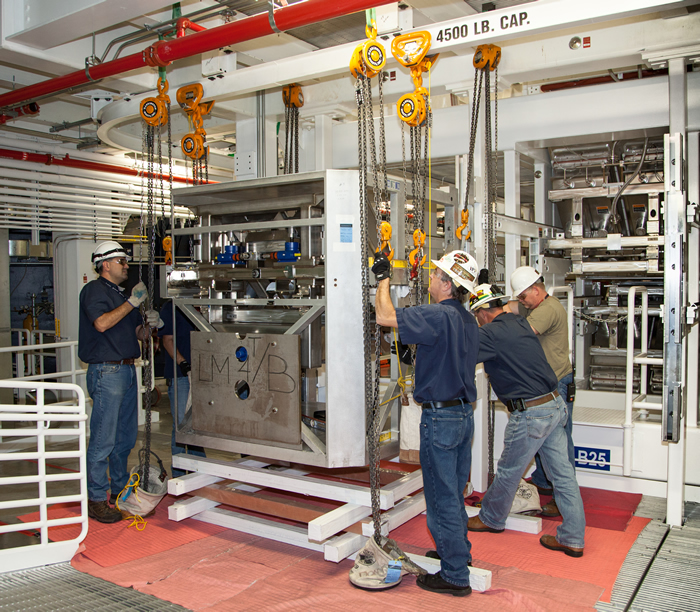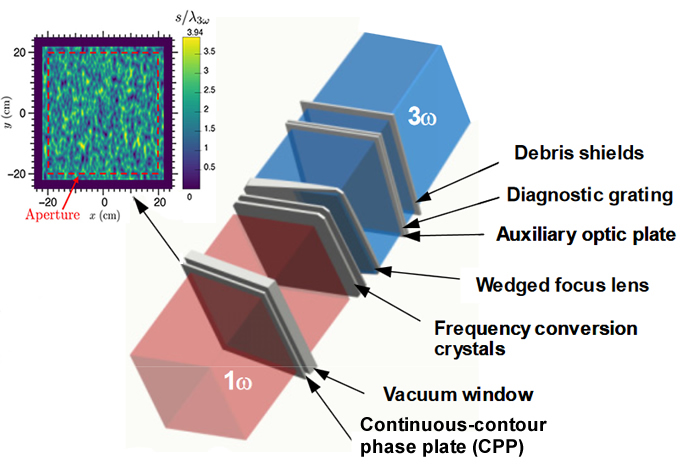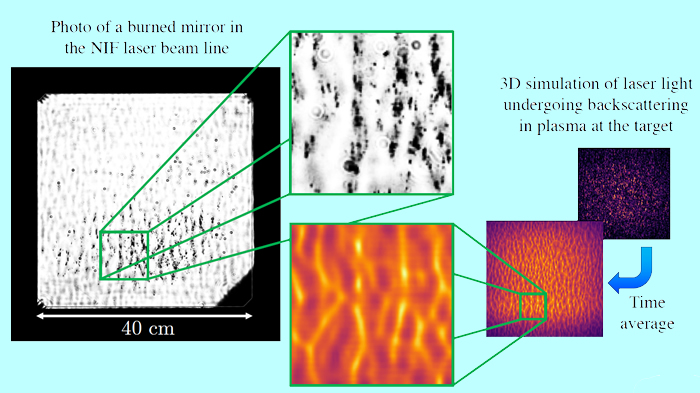Understanding Optics Damage from Reflected Laser Light
LLNL researchers have found an answer to a persistent question: why do mirrors burned by light backscattered from NIF targets show such characteristic and consistent patterns?
When the intense ultraviolet light from NIF’s powerful laser beams interacts with plasma (ionized gas) that forms at or near a target, some of the energy can be reflected back through the beamlines like light bouncing off a mirror. This “backscattered” high-frequency light can burn the sensitive surface of the transport mirrors that direct the laser light to the target.
 Transport & Handling Team members remove a laser mirror from the beampath for transport to the Optics Assembly Building for replacement. Credit: James Pryatel
Transport & Handling Team members remove a laser mirror from the beampath for transport to the Optics Assembly Building for replacement. Credit: James Pryatel A new study demonstrates that optics called continuous-contour phase plates (CPPs) in the Final Optics Assembly are responsible for concentrating the scattered light into damaging hot spots back on the mirrors. This opens a new direction for reducing the damage caused to mirrors by redesigning or repositioning the CPPs.
“We’ve wanted to know why mirrors burned on the NIF look the way they do for more than six years,” said physicist Tom Chapman, lead author of a Journal of Applied Physics paper published online on Jan. 15 and featured in an American Institute of Physics “Scilight.” “It’s good to finally have an answer, and it might lead to new ways to reduce the damage.”
While the multi-layer, high-reflectivity dielectric coatings on NIF’s mirrors generally are able to withstand the energy from the laser’s initial infrared, or lower-frequency, laser light, the mirrors are particularly susceptible to damage by the ultraviolet light reflected by the target by a process called stimulated Brillouin scattering (SBS).
Damaging high-backscatter events at NIF are rare, the researchers said, but when they do occur maintenance inspections of the mirrors reveal a consistent, highly structured burn pattern that can degrade the mirror coating to the extent that replacement is necessary, resulting in significant expense and lost time for experiments.
In their study, the researchers used a measurement of a NIF phase-plate profile to provide the laser data for a three-dimensional simulation of laser-plasma interaction in a typical NIF target. The simulation followed light scattered at the target by SBS back to the final aperture of the beamline, then back through the phase plate, and finally to the 8th and final mirror in the beamline, known as LM8, where damage typically occurs.
 A NIF final optics assembly consists of four integrated optics modules containing the final optics for each laser beam. The frequency conversion crystals (harmonic converters) change the beam’s wavelength from 1-omega (infrared) to 3-omega (ultraviolet), while the continuous-contour phase plates (CPPs) provide focal spot conditioning. At left is an example of the imprint on transmitted light from a NIF phase plate.
A NIF final optics assembly consists of four integrated optics modules containing the final optics for each laser beam. The frequency conversion crystals (harmonic converters) change the beam’s wavelength from 1-omega (infrared) to 3-omega (ultraviolet), while the continuous-contour phase plates (CPPs) provide focal spot conditioning. At left is an example of the imprint on transmitted light from a NIF phase plate. Phase plates are transparent glass optics that are placed in the beampath in front of the focusing lens in the final optics assembly. Nanometer (billionth of a meter)-scale thickness variations across the optic enables the phase plate to change the shape and intensity of the focused laser beam. Careful design of the phase plate surface topography creates complicated focal spot shapes tailored to experimental needs.
‘Remarkable’ AgreementCalling the agreement between the results of the simulation and the damage patterns on NIF mirrors “remarkable,” the researchers said the study found that “mirror damage patterns are largely dictated by the (impact) of the phase plate on the returning SBS light.”
 Comparison of a 3D simulation of backscattered laser light with a region of a damaged NIF mirror shows close agreement between the experimentally observed burn pattern and the simulated SBS intensity pattern. Credit: Tom Chapman
Comparison of a 3D simulation of backscattered laser light with a region of a damaged NIF mirror shows close agreement between the experimentally observed burn pattern and the simulated SBS intensity pattern. Credit: Tom Chapman “I think this work marks the beginning of a new era of large-scale integrated modeling for high-power laser systems,” said NIF & PS physicist Pierre Michel, the Laser-plasma Applications Group leader. “Tom’s simulations bridge the gap between the physics models used by the target scientists and the laser scientists.”
“Our work is directly relevant to any current or future laser facility with similar design and damage concerns to the NIF,” the researchers said, “and should influence damage mitigation strategies, including future designs of phase plates. Reducing the SBS modulation depth imparted by the CPP at a transport mirror was not part of the design process for the CPPs currently installed at the NIF. Changing the details of the CPP design may offer a reduction in optical damage while maintaining desirable far field properties of the laser light.”
Other strategies to mitigate optical damage from SBS scattering mentioned in the paper include:
- Reducing the distance between the CPP and mirrors, as the time-integrated modulation depth increases with propagation distance from the CPP. The researchers suggested that “this simple consideration should perhaps be part of the design of future laser systems.”
- Employing new ultraviolet light filters to protect sensitive components in the beam line. “Knowledge of the target-generated spatio-temporal intensity of SBS along the beam line may inform where best to place such filters,” the researchers said.
Along with Chapman and Michel, contributors to the article, “Investigation and modeling of optics damage in high-power laser systems caused by light backscattered in plasma at the target,” were LLNL’s Jean-Michel Di Nicola, Dick Berger, Pam Whitman, John Moody, Ken Manes, Mary Louise Spaeth, Mikhail Belyaev, Cliff Thomas, and Brian MacGowan.
More Information
“Understanding and protecting against backscattered light in high-power laser systems,” American Institute of Physics “Scilight,” Jan. 18, 2019.
—Charlie Osolin
Follow us on Twitter: @lasers_llnl



